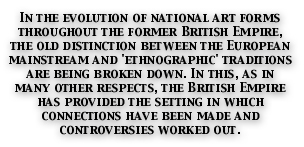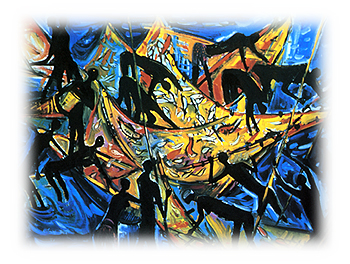|
For much of the Nineteenth Century British opinion had tended to denigrate the art of non-Europeans. It was seen as 'ethnic' - wholly separate from the history of the 'progressive', 'advanced', arts that had evolved in the west. Even Chinese art, which had so intrigued Eighteenth Century connoisseurs, fell into disrepute for a time. James Mill, in what was for long accepted as the authoritative History of India, pronounced in 1817 that Indians were 'entirely without a knowledge of perspective and by consequence of all those finer and nobler parts of painting which have perspective for their requisite basis.' According to the great critic John Ruskin, Indians could 'not produce any noble art, only a savage or grotesque form of it.'
British opinion tended to make a sharp distinction between 'art', in which Indians were generally judged to be seriously deficient, and 'crafts', at which they excelled. The design and decoration of Indian textiles, earthenware, and toys shown in London in 1851 at the Great Exhibition drew much admiration. Ruskin shared this admiration, as did William Morris, who praised Indian decorative arts for being 'at once beautiful, orderly. living in our own day, and, above all, popular'. If Indians were at least allowed to be skilled at crafts, most of the peoples of Africa or the Pacific were regarded as having neither arts or crafts. Their artefacts were seen as bereft of aesthetic value. It was assumed that their carved figures had religious significance and were thus idolatrous to Christian opinion. Missionaries described figures from the pacific as 'so ridiculously fantastic, so monstrously uncouth, so frightfully distorted'. Such things could be collected and displayed merely to illustrate the life of 'primitive' people, as a tool of what was combing to be known as anthropology.
By the end of the Nineteenth Century, however, European connoisseurs were beginning to give serious attention to non-European art. Enthusiasm for the bronzes of Benin in Nigeria spread to African carving and sculpture in general. In 1910 a group of artists and intellectuals published a letter in The Times, praising the Indian 'school of national art' for 'its vitality and its capacity for the interpretation of Indian life and thought'. Some British artists derived inspiration for their work from non-European art. Japanese prints were very much admired and were very widely imitated.
Post-impressionists like Georges Braque and Pablo Picasso became enthralled by the representational, geometric, and spiritual character of the African mask and sought to incorporate some of its characteristics in their art. Examples of African sculpture adn metal work, which had often been looted in colonial campaigns and then relegated to the ethnographic departments of western museums, came to hvae a new signficance for western art.
In the search for uniquely national forms, the artists of the Dominions began to draw upon motifs, pigments, and spiritual concepts of indigenous art. By the middle of the Twentieth Century, this fusing of local symbols with European techniques had become standard throughout the territories of white settlement. Part of this revolutionary interest lay in a renewed fascination with design and motif. In New Zealand there was a fresh concern with the magnificent carvings of Maori canoes, or in the gloriously carved and decorated churches produced by Maori builders and artists in the mid-Nineteenth Century, such as that at Otaki, completed in 1851. By the middle of the Twentieth Century New Zealand art was attempting to fuse international movements with Maori motifs.
Something of the same development occurred in Australia, where aboriginal art remains a living tradition. Today Aborigine painters still decorate rocks with modern versions of the art of their ancestor; others transfer Aboriginal designs onto various fabrics. In Canada, the art of the Indian totem of the north west coast and of Inuit sculpture and design has similarly entered the artistic mainstream.
In South Africa, the great tradition of rock painting by the San people was rediscovered in the interwar years. Soon African artists were beginning to be accepted and encouraged in their own terms. By the 1950s an entire school of artists had emerged in Johannesbury, associated with the Polly Street Art Centre. They developed a tradition known as 'township art' which placed African designs and ways of looking at the world into new contexts, sometimes influenced by the social and economic realities of the urban setting. Africans were thus feeding back into a European tradition insights derived from the long standing abstract core of African art.
If Imperial art had so often expressed the power of dominant peoples, the nationalist responses of the Twentieth Century inspired a new confidence both on the part of the displaced white societies, whose arts had so often seemed borrowed and second-rate, and more particularly in the achievements of indigenous cultures. In the ex-Dominions attempts at fusion produced syncretic forms of art which pointed the way to distinctive cultures which could secure international recognition in their own right. In the case of India and Africa the development of an art confident in its integrity helped to constitute a vital cultural ingredient in their poltical re-awakenings. Throughout the former empire distinctions between European and 'ethnographic' traditions have all but disappeared, as each culture society manages to find its own distinctive voice shaped by its own unique geography, traditions and peoples.
|


